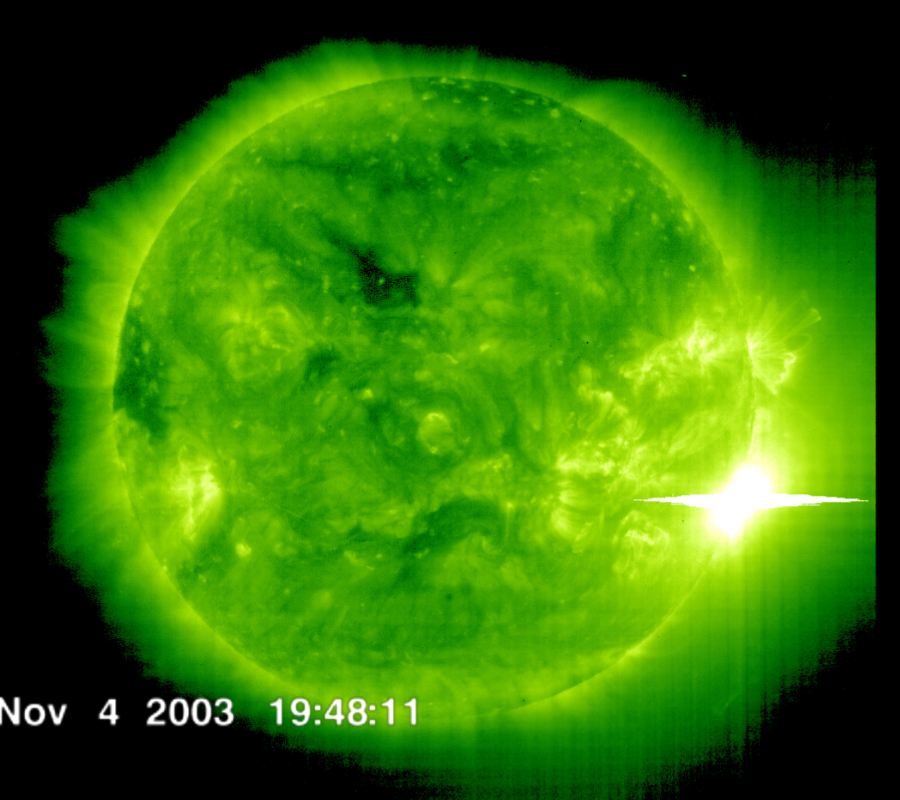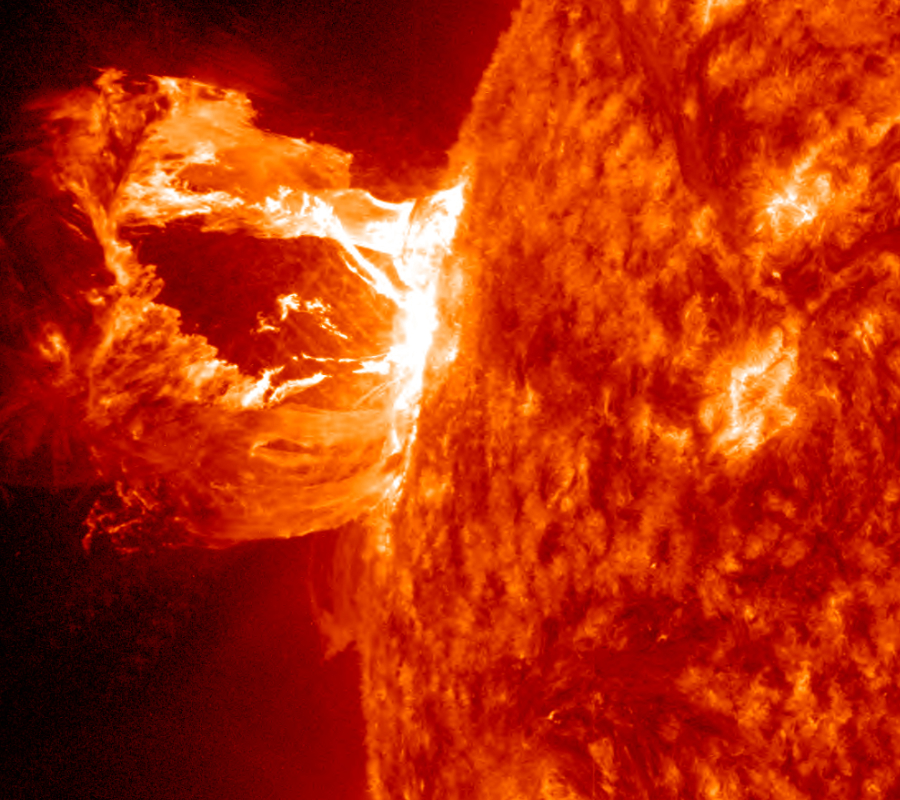A recent study published in Space Weather analyzed the chance of a solar storm occurring in the next decade, alongside its costs and implications for humans on Earth.
Researchers from the Cambridge Centre for Risk Studies at the University of Cambridge measured the economic implications of a blackout scenario caused by a severe solar storm, which would translate to over $41.5 billion in costs due to the destruction of generators and power grids.

Although there is no consensus on how the blackout will manifest itself, as it depends on how the coronal mass ejection occurs, some electrical engineers believe that the power outages may last just a few hours, while others assure that cities will be left without power for months because the transmission networks would be destroyed, calling for a replacement.
Has this happened before on Earth?
The potential damage that a solar storm could cause in a near future is measured against the “Carrington Event” which took place in 1859. It was a coronal mass ejection that blasted Earth’s magnetosphere, recorded by English astronomer Richard C. Carrington.
In late August of 1859, sunspots started appearing on our nearest star, making auroras appear in unlikely places such as Queensland, Australia. The flare took 17 hours to transverse 93 million miles to collide with Earth. After the flare hit, auroras started appearing on the Caribbean, the Rocky Mountains, Northern Africa, Hawaii, and even Colombia, which is next to the equator. It was reported that the flare was so intense that miners in the U.S. got up to make breakfast because they thought the sun had risen up.

Regarding its effects, telegraphs failed in the whole world, giving electric shocks to their operators, although some could keep sending and receiving messages even if they had their power supply disconnected.
The probability that another Carrington flare could occur within the next 10 years is 12 percent, according to a paper authored by Pete Riley from Predictive Sciences Inc. Others suggest that, although the probability of a solar storm occurring in the near future is very low, “it is almost inevitable that one will occur eventually,” as suggested by the Atmospheric and Environmental Research.
Such an event would cause losses of billions of dollars, including government affairs, finances, manufacturing, and even international relations. Researchers proposed that if only northern regions of the U.S. are affected, the loss could reach $6.2 billion. If the solar flare affected 23 percent of the population, it would cost $16.5 billion per day. But if the flare affected 44 percent of the population, it would cost $37.7 billion in the U.S. plus $4.8 billion globally. All rates were calculated using the value of the U.S. dollar back in 2011.
Dealing with space weather
Mark Gibbs, Met Office Head of Space Weather, suggests that the best way to avoid the damage caused by a coronal mass ejection is to accurately predict and measure the event. The best way to do this would be to have a permanent operational spacecraft capable of providing a side-view to the coronal mass ejections, which would provide an accurate estimate of its speed.
Throughout the Earth-sun orbit, there are certain points which enjoy gravitational stability, known as Lagrange points. Gibbs proposed the European Space Agency to launch a spacecraft at Lagrange point 5 to have better measurements of space weather, thus allowing us to act on advance against solar storms directed toward Earth.

Gibbs hopes that this UK-based mission will be put into action somewhere around 2020, as it could also be joined by a U.S. mission that would set a spacecraft at Lagrange point 1, located between the Earth and the sun.
As recent as 2012, our planet dodged a solar flare which occurred on the other side of the sun. This flare was much larger than the Carrington Event. Scientists also agree that solar storms can occur much more frequently than they are able to hypothesize. This is true for most cosmic events that would mean catastrophic times for Earth. Related events would be the death of stars, which are known to occur at least once every 100 years in our galaxy. Supernovae are most likely to explode as they are closer to the center of the Milky Way, while Earth sits somewhere around two-thirds of the way from the middle.
When a star runs out of fuel, its mass collapses down to its core, forcing it to explode due to its own gravitational force. If a supernova exploded as near as 50 light years away from Earth, its radiation would decimate out ozone layer. However, we can rest assured, seeing that the nearest star that’s nearing the end of its cycle as a red giant is Betelgeuse, located at least 460 light years away. It is expected to explode within the next million years. On the other hand, solar flares are much harder to predict than the death of stars.
Source: American Geophysical Union

So they’re speculating. Astronomers and meteorologists can’t even predict the weather without error. And look what happened with that “shoe-in win” for Hillary. They should stop thinking, they’re weakening the nation!
The article reads $40B ‘daily’. Not a total of $40B. Why don’t they use a fraction of that $ and spend it on building Faraday cage type protection for the grid now and be proactive instead of reactive. It’s not like they aren’t already aware of how the damage occurs and how to protect the grid.
Thanks Teri! At least one person is awake out there… Kudos to U!
since electromagnetic impulse is figured in every war scenario i would say the next one will be sooner than later is much higher than predicted…
Saying it might cost 41 Billion is really ridiculous, without a financial system, banks, computer networks, tax authority’s to collect revenue, where are you going to get 41 billion?
U S military spending accounts for 600 billion in tax payer money in one year. Over 50 percent of federal spending. Heaven forbid the feds might have to cough up 40 billion to repair the grid.
Because that’s just pure socialism right there.
Well as Teri stated why do they not over a period of say ten years build protections into the systems so that if one occurs we will be significantly less affected by it!
These guys can barely acknowledge the temperature of the Earth rising a degree or two year by year and causing climate fluctuations. They call that a hoax put together by alarmists who like to stir up trouble. This isn’t a projection. It’s happening NOW live and in color and they poopoo it. You and Teri expect those same people to acknowledge something that COULD happen according to scientists and then react by having a budget for it? The same people who call anything in the budget other than war material PORK BELLY? Kevin and Teri…good luck.
It’s all Bush’s fault.
Oh crap.
The inauguration, is over.
So naturally, it’s Trumps fault. Along with, global warming,
Obama, pointed this out, a few times. (sarc)
Bush 1, Bush 2, or the Bush’s Beans Company?
oh the first marine found the bean of parley-voo…
What does that post even mean? @ bonobojean
the first marine found the bean of parley-voo
the second marine cooked the bean of parley-voo
the third marine ate the bean and blew a hole in the submarine.
Inky, dinky parl-ley-voooooooooooooooooooo….